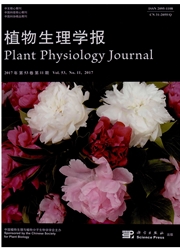

 中文摘要:
中文摘要:
氨基酸透性酶(amino acid permeases)在植物不同器官的氨基酸转运过程中发挥着重要作用,但迄今为止,大豆中氨基酸透性酶相关的研究甚少。本文利用大豆初生叶水培系统对大豆(Glycine max)品种‘Williams 82’进行缺氮处理后,发现与足氮对照相比,大豆初生叶中Gm AAP2-like 1基因的表达明显上调。对大豆不同器官中Gm AAP2-like 1的转录水平进行RTPCR检测,结果显示该基因在花、叶和茎中的表达量较高而在根和种子中表达量很低。构建Gm AAP2-like 1(无内含子)过表达植物表达载体,在转化农杆菌时发现,该载体转化农杆菌GV3101致死;改进载体构建策略,采用融合PCR方法,在Gm AAP2-like 1的第一个外显子后插入一段内含子序列,改进的载体可以成功转化农杆菌。应用农杆菌介导的花苞浸泡法转化拟南芥,对所获得的转基因拟南芥抗性苗进行基因组PCR和RT-PCR鉴定,共检测到8个Gm AAP2-like 1不同程度表达的转基因拟南芥株系,且其中的内含子都得到了正确的剪切。氨基酸有毒类似物(MSX)处理实验表明:转基因拟南芥对MSX处理比野生型更为敏感,暗示Gm AAP2-like 1具有运输谷氨酸等酸性氨基酸的功能。
 英文摘要:
英文摘要:
Amino acid permeases play important roles in transferring amino acids between different parts of the plants; however, so far their functions have rarely been studied in soybean. In this research, an amino acid permease gene, Gm AAP2-like 1, was seen to be up-regulated in primary leaves of hydroponically grown soybean(Glycine max) cultivar ‘Williams 82' under nitrogen-deficiency treatment compared with nitrogen-sufficient control. The RT-PCR analysis further showed that Gm AAP2-like 1 was much more abundantly in flowers, leaves and stems of soybean while it showed very low expression in roots and seeds. During the cloning process, it was found that the vector carrying 35S:Gm AAP2-like 1 could be transformed into Escherichia colistrain DH5α successfully but was lethal to Agrobacterium tumerfaciens strain GV3101. As an alternative strategy, this gene was then cloned by fusion PCR with an intron inserted after the first extron and the following transformations turned out to be successful in both E. coli and Agrobacterium strains mentioned above. Subsequently, the obtained Arabidopsis thaliana transgenic lines of 35S:Gm AAP2-like 1 with intron were verified by genomic PCR and semi-quantitative RT-PCR analysis, and the results showed that the intron was cut off correctly and the gene of interest was over expressed in almost all the lines examined. Furthermore, it was shown that even though the growth of wild-type and transgenic seedlings were both inhibited after toxic glutamate analogues treatment in comparison to that of the mock control, the growth inhibition of transgenic lines was much more significant, implying that Gm AAP2-like 1 could possibly transport such acidic amino acid.
 同期刊论文项目
同期刊论文项目
 同项目期刊论文
同项目期刊论文
 期刊信息
期刊信息
